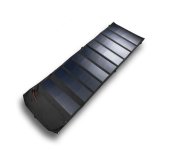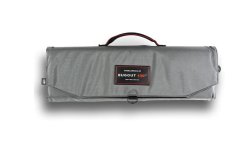Ok, I'm working on a solar system with the help of a friend that has quite a bit of knowledge and experience with solar. And doing a lot of my own research and decision making on exactly what I want. I'll begin to document the process here.
I had not desired solar power before, but after spending 4 nights at Mackinac Island, where the marina was still officially closed due to construction, but some slips were allowed to be used, but with out electric power and rules against running a generator, the idea of solar began to take hold. My "toad" cable when towing hardly keeps up with the boat's freezer and refrigerator draw, and forget about putting any charge into the batteries. (It does do ok without the freezer along.) And there are a few other rare occasions where having solar would be helpful when in other locations for more than a day without electricity and restrictions on generator use.
I started out considering flexible and portable panels. But as my priorities revolved, I realized I would need something more permanent if I were to also use the solar while trailering. And then there is the issue of storage for portable panels when not in use. So that lead to my decision of going with the more solid panels.
From the beginning I figured 200 watts would be a good number to go with, and with my space desires, not really room for much more than that in a more permanent installation. Here are some pictures of my roof, and what my space limitations are.
This is a stern shot of my roof. I have my mast light folded down in this picture. The mast light is on a pole 33" tall. It's that tall to clear my kayaks when they are stored up on the roof. I need access behind the anchor light to allow it to lay flat when folded down for traveling, or not in use. The port VHF antenna mounts on the handrail just a few inches back, allowing room for the kayak rack to mount. It also folds aft when stowed for travel, and lays next to the hand rail.
This is a view with my kayak rack pvc mockup. The final rack is exactly the same, but made out of SS and uses hinged tees to mount to the hand rail. It sits high enough that will not be in the way of the solar panels. Depending upon sun angle, there may be some shadows produced on the solar panels. However, the rack is not installed when trailering, and if I'm sitting somewhere for more than a day and want solar power, the kayaks can be taken down.
This is a picture with the bikes and bike rack on the roof. Only time I used it was for the Erie Canal. I'll have to cross this bridge later, but I'm not sure there will be enough space between the bike rack cross member and the center of the roof, for the solar panels. I may end up not being able to use the bike rack with the solar panels installed.
With all this in mind, my space choice is to install two panels small enough to fit between the hand rail and the mast light, on both the port and starboard side. That still leaves me a little bit of room on the back of the roof if I decide later to put another panel there, or to store the rolled up kayaks there without the kayak roof rack. Colby





